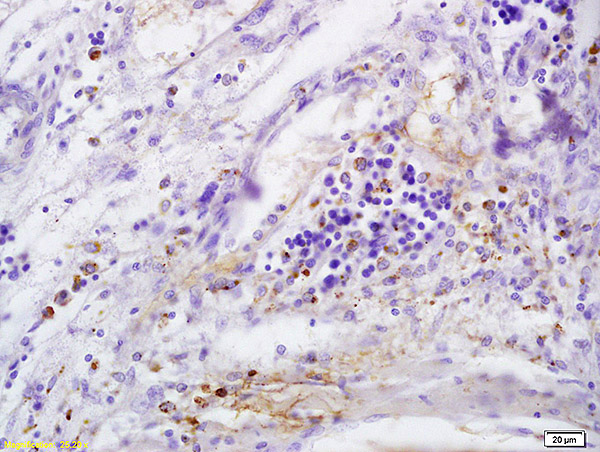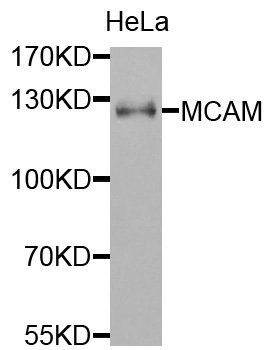
Immunohistochemical staining of formalin fixed and paraffin embedded human breast cancer tissue sections using Anti-CD146 RM249 at a 1:400 dilution.
anti-CD146 (human), Rabbit Monoclonal (RM249)
REV-31-1129-00
ApplicationsWestern Blot, ImmunoHistoChemistry
Product group Antibodies
ReactivityHuman
TargetMCAM
Overview
- SupplierRevMAb Biosciences
- Product Nameanti-CD146 (human), Rabbit Monoclonal (RM249)
- Delivery Days Customer10
- ApplicationsWestern Blot, ImmunoHistoChemistry
- CertificationResearch Use Only
- ClonalityMonoclonal
- Clone IDRM249
- Gene ID4162
- Target nameMCAM
- Target descriptionmelanoma cell adhesion molecule
- Target synonymsCD146, HEMCAM, METCAM, MUC18, MelCAM, cell surface glycoprotein MUC18, Gicerin, S-endo 1 endothelial-associated antigen, cell surface glycoprotein P1H12, melanoma adhesion molecule, melanoma-associated antigen A32, melanoma-associated antigen MUC18
- HostRabbit
- IsotypeIgG
- Protein IDP43121
- Protein NameCell surface glycoprotein MUC18
- Scientific DescriptionCD146 (MCAM; MUC18) is an integral membrane glycoprotein belonging to the immunoglobulin superfamily. It is a 113kDa cell adhesion molecule currently used as a marker for endothelial cell lineage. CD146 is expressed at cell-cell junctions in all endothelial cells, and has also been observed in other normal and malignant cell types. CD146 functions as a receptor for laminin alpha 4, a matrix molecule that is broadly expressed within the vascular wall. Accordingly, CD146 is highly expressed by cells that are components of the blood vessel wall, including vascular endothelial cells, smooth muscle cells and pericytes. In addition to its recognized role as a calcium-independent cell adhesion molecule, CD146 may also act as a signal transduction molecule in the recruitment of Fyn kinase, and in the subsequent tyrosine-phosphorylation of intracellular proteins involved in actin cytoskeleton assembly. CD146 plays a role in cell adhesion, and in cohesion of the endothelial monolayer at intercellular junctions in vascular tissue. Normal melanocytes do not express CD146, but CD146 expression is positively correlated to melanoma progression. - Recombinant Antibody. This antibody reacts to human CD146 (Cell surface glycoprotein MUC18). This antibody may also react to mouse or rat CD146, as predicted by immunogen homology. Applications: WB, IHC. Source: Rabbit. Liquid. 50% Glycerol/PBS with 1% BSA and 0.09% sodium azide. CD146 (MCAM; MUC18) is an integral membrane glycoprotein belonging to the immunoglobulin superfamily. It is a 113kDa cell adhesion molecule currently used as a marker for endothelial cell lineage. CD146 is expressed at cell-cell junctions in all endothelial cells, and has also been observed in other normal and malignant cell types. CD146 functions as a receptor for laminin alpha 4, a matrix molecule that is broadly expressed within the vascular wall. Accordingly, CD146 is highly expressed by cells that are components of the blood vessel wall, including vascular endothelial cells, smooth muscle cells and pericytes. In addition to its recognized role as a calcium-independent cell adhesion molecule, CD146 may also act as a signal transduction molecule in the recruitment of Fyn kinase, and in the subsequent tyrosine-phosphorylation of intracellular proteins involved in actin cytoskeleton assembly. CD146 plays a role in cell adhesion, and in cohesion of the endothelial monolayer at intercellular junctions in vascular tissue. Normal melanocytes do not express CD146, but CD146 expression is positively correlated to melanoma progression.
- ReactivityHuman
- Storage Instruction-20°C
- UNSPSC12352203






